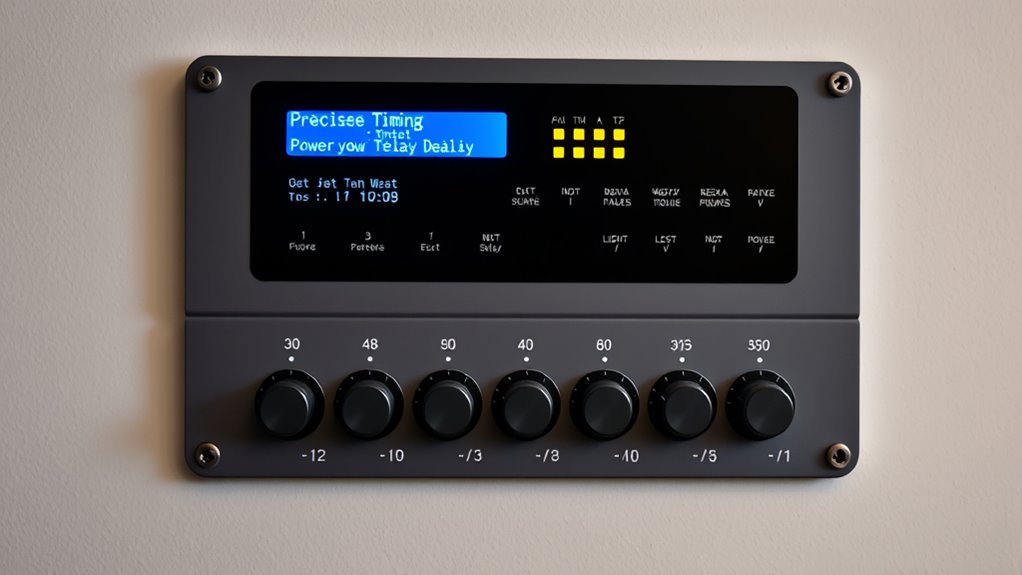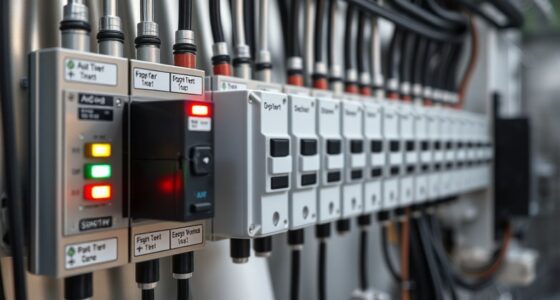To properly program transfer switch time delays, you should set specific delay times to prevent rapid switching during power fluctuations. These delays allow your generator enough time to start and stabilize before transfer, reducing equipment stress and power interruptions. You can typically adjust delays using user interfaces or displays, ensuring the settings match your generator’s startup and shutdown times. Continuing here will help you understand how to optimize these settings for safe, reliable operation.
Key Takeaways
- Transfer switches use time delays to prevent rapid cycling during transient power fluctuations and ensure stable switching.
- Programming delay times allows customization based on generator startup times and system requirements.
- Delays are set through user interfaces like keypads or digital displays, following manufacturer instructions.
- Proper delay configuration minimizes equipment stress, reduces unnecessary outages, and enhances system reliability.
- Regular review and adjustment of delay settings optimize backup power system performance and safety.

When it comes to transfer switches, understanding time delays and programming is essential for ensuring your backup power system works smoothly. These switches are crucial for safely and effectively shifting between utility power and generator power during outages. One key aspect to master is how automatic transfer switches handle time delays. An automatic transfer switch (ATS) is designed to detect power loss automatically and switch to backup power without manual intervention. However, to prevent unnecessary or rapid switching, most ATS units incorporate time delays. These delays give the generator time to start up and stabilize before the switch occurs, avoiding potential damage caused by switching during transient power fluctuations. Properly configured, electric power generation with bike generators demonstrates the importance of managing startup times and delays for efficiency. Programming these time delays correctly is vital. Many automatic transfer switches allow you to set specific delay times, typically ranging from a few seconds to several minutes. For instance, a common setup might include a brief delay after detecting power loss, ensuring the utility power isn’t just momentary flickering. Similarly, a delay after restoring utility power ensures that the system doesn’t switch back too quickly, which could cause wear and tear on your equipment. When you’re configuring your transfer switch, you need to understand the importance of these delays and tailor them to your specific needs. If your generator takes longer to start, you’ll want to increase the delay time so the switch doesn’t attempt to transfer before the generator is ready. Conversely, if you want minimal downtime, shorter delays might be suitable, but be cautious not to compromise system stability. Manual programming plays a significant role if your transfer switch offers customizable settings. With manual programming, you can fine-tune the delay times, often through a user interface, keypad, or digital display. This flexibility allows you to adapt the system to your generator’s startup time, load requirements, and overall backup plan. It’s important to follow manufacturer instructions carefully to avoid setting delays too short, which can cause rapid cycling, or too long, which might leave you without power longer than necessary. Regularly reviewing and adjusting your programming ensures your transfer switch operates at its best, reducing unnecessary wear and improving reliability. Ultimately, understanding how to set and manage time delays through automatic transfer and manual programming is fundamental to a dependable backup power system. Proper configuration minimizes equipment stress, reduces power interruption times, and maintains safety during transitions. Whether you’re setting delays automatically or manually, taking the time to understand and customize these parameters ensures your system responds precisely when you need it most.
Frequently Asked Questions
Can Transfer Switch Delays Be Adjusted Remotely?
Yes, you can typically adjust transfer switch delays remotely if it has smart features or is connected to a compatible control system. Remote adjustment allows you to modify delay configuration without being physically present at the switch. You’ll need to access the switch’s app or control panel, where you can easily change delay settings, ensuring your transfer switch operates exactly how you want it, even from a distance.
What Are the Risks of Improper Programming?
If you improperly program your transfer switch, you risk fault detection issues that could delay or prevent proper power transfer. This can lead to safety hazards, such as electrical shorts or overloads, putting you and your property at risk. Incorrect settings may also cause unnecessary power interruptions or failures during outages. Always double-check your programming and consult the manual or a professional to guarantee safe, reliable operation.
How Do Delays Affect Generator Longevity?
Think of delays like a slow dance; they can strain your generator’s components. When delays are too long or inconsistent, it accelerates wear and tear, reducing generator longevity. Proper transfer switch programming guarantees smooth, timely transfers, boosting power reliability and minimizing maintenance needs. Ignoring these delays risks costly repairs and downtime, so keep your system well-tuned to extend your generator’s life and maintain steady power.
Are There Industry Standards for Delay Settings?
Yes, industry standards for transfer switch delays exist to guarantee safety and equipment longevity. You should follow manufacturer recommendations and local codes, which often specify delay settings for automatic transfer switches. Proper programming standards help prevent false alarms or unnecessary generator starts. It is crucial to verify these standards and adjust transfer switch delays accordingly, ensuring reliable power transfer while protecting your generator and electrical system from damage.
Can Delays Be Customized for Different Load Types?
Ever wondered if you can customize delays for different load types? You definitely can, as modern transfer switches allow you to adjust delay calibration based on load compatibility. This guarantees smoother transitions and prevents unnecessary transfers with sensitive equipment. By tailoring delay settings, you optimize performance for various loads, reducing wear and tear on the system. Customizable delays help you maintain reliable power transfer tailored specifically to your unique load requirements.
Conclusion
Now that you understand transfer switch time delays and programming, you’re basically a superhero ready to conquer any power outage! With your newfound knowledge, you can prevent chaos, save your entire household from electrical disasters, and keep your appliances running smoothly like a well-oiled machine. Nothing can stand in your way now—you’re unstoppable! So go ahead, tweak those delays, and turn into the ultimate master of backup power. The power is in your hands!









